|
|
|
Sort Order |
|
|
|
Items / Page
|
|
|
|
|
|
|
| Srl | Item |
| 1 |
ID:
111568
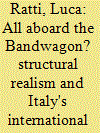

|
|
|
|
|
| Publication |
2012.
|
| Summary/Abstract |
Italy's foreign and security policy since the end of the Cold War is best accounted for by a structural realist framework rather than by liberal and constructivist accounts. More specifically, since unification and also in the post-Cold War period, the main feature of Italy's international collocation has been a dialectical interaction between a structural tendency to "bandwagon" with the hegemonic Power, which can guarantee the protection of Italian interests and forestall the risk of exclusion, and the search for regional autonomy. Italy's structural, dialectical interaction between "bandwagoning" and the search for autonomy is a response to opposite systemic incentives: Italy "bandwagons" every time the international status quo unravels or when a new order is being imposed; it endeavours to assert a more independent role in periods of international stability. During the Cold War, Italy bandwagoned with the United States, whilst European integration and a limited number of initiatives in the Mediterranean saw it attempt to preserve a degree of regional autonomy. The end of the East-West division, replacing scenarios of a nuclear attack or of conventional warfare along the East-West border with the unpleasant prospect of "entrapment" in neighbouring local crises, rekindled the tension between Italy's structural tendency to side with the hegemonic Power and its aspiration to regional autonomy.
|
|
|
|
|
|
|
|
|
|
|
|
|
|
|
|
| 2 |
ID:
103194


|
|
|
|
|
| Publication |
2011.
|
| Summary/Abstract |
Three theories that can be usefully employed to analyse the security of the Black Sea region are structural realism, security communities and supranationality (based on the European Union (EU) model). Given that the Black Sea area currently has too many conflicts and rivalries to be a truly cooperative region or a 'security community', we must examine its dynamics in terms of its present realism, especially in the east of the region ('what is'), as well as considering its future ('what could be'). Regionalisation and Europeanisation are both possibilities for the longer term but, for the development of a fully cooperative region, possibly based on the EU model, it is posited that a condition of 'balanced multipolarity' must initially exist. The paper analyses the extent to which this type of polarity applies at the moment and then uses all the theories to outline possible ways forward for the region.
|
|
|
|
|
|
|
|
|
|
|
|
|
|
|
|
| 3 |
ID:
092033
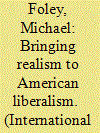

|
|
|
|
|
| Publication |
2009.
|
| Summary/Abstract |
Despite being a period of reputed liberal ascendancy and settlement in the United States, the 1950s also marked a time of considerable uncertainty, not least in the matter of America's own identity in relation to the rest of the world. Louis Hartz's quintessential depiction of US development threw into high relief the problematic nature of a liberalism that fluctuated between the two poles of principled withdrawal and transformative engagement. This article examines the social and political context of Waltz's Man, the State, and War in relation to the specific issue of the American liberal predicament during the emergence of the cold war. Waltz's work tapped into deep political insecurities generated by the onset of an apparently unstable and dangerous international order that threatened to be exacerbated by America's own indigenous ambiguity over its international position. Waltz illustrated a way by which it was possible for American liberalism, and thereby the United States, to achieve a stable and sustainable form of international involvement without falling prey to the violent swings between the Hartzian extremes of liberal overreaction. Waltz's kind of realism contained a positive core that implicitly addressed the issue of American engagement in the international system. In effect, the dynamics of international bipolarity had enhanced the possibility of diminishing the chronic nature of liberalism's own bipolarity.
|
|
|
|
|
|
|
|
|
|
|
|
|
|
|
|
| 4 |
ID:
132553
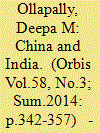

|
|
|
|
|
| Publication |
2014.
|
| Summary/Abstract |
How well do theories of economic interdependence and structural realism explain the India-China divergence between growing economic relations and continuing strategic mistrust? This article looks at the Indian side and argues that we need to go beyond economic and strategic factors, and brings in a more contingent approach based on domestic elite discourse and thinking. The article suggests that a more nuanced and complex debate on China is emerging in India than that posited by interdependence or realism, a debate that is framed by what I term nationalist, realist and globalist schools of thought, with the latter two groups currently holding the center of gravity.
|
|
|
|
|
|
|
|
|
|
|
|
|
|
|
|
| 5 |
ID:
017945
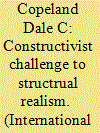

|
|
|
|
|
| Publication |
Fall 2000.
|
| Description |
187-212
|
|
|
|
|
|
|
|
|
|
|
|
|
|
|
|
| 6 |
ID:
092038
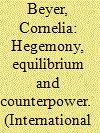

|
|
|
|
|
| Publication |
2009.
|
| Summary/Abstract |
This article claims that realist and constructivist ideas are compatible. Structural realism is needed to understand the constraining and stabilizing role of material factors. Furthermore, it detects process in a law-like tendency towards international power equilibrium which is achieved via balancing. Constructivism, in turn, highlights the importance of ideas and norms as engines for change and the creative role of agency. The article therefore combines a materialist and an idealist perspective. It both detects elements of stability and argues for necessary improvements in current international relations (IR) by looking at the issues of United States hegemony, the rise of new challengers and the threat of sub-state international terrorism. This article, therefore, takes up important claims made by Kenneth Waltz on realism, hegemony and terrorism, and interprets them in the light of IR theory today. It is argued that structural realism and Waltz's ideas are still important and viable, but that we need to combine them with additional perspectives, notably constructivism.
|
|
|
|
|
|
|
|
|
|
|
|
|
|
|
|
| 7 |
ID:
146232
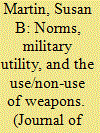

|
|
|
|
|
| Summary/Abstract |
The role of norms and military utility in the use of weapons is disputed by constructivist and realist scholars. Through an examination of US decision-making regarding anti-plant and irritant agents in the Vietnam War, I advance this debate in three key ways. First, I develop structural realism’s expectations regarding the role of military utility. Second, I demonstrate that social and material factors are at play in our understandings of both ‘norms’ and ‘military utility’, and that both played a role in US decisions. Third, I find that the dominant role – as structural realism expects – was played by military utility.
|
|
|
|
|
|
|
|
|
|
|
|
|
|
|
|
| 8 |
ID:
090862
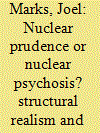

|
|
|
|
|
| Publication |
2009.
|
| Summary/Abstract |
With mounting concern over Iran's nuclear ambitions and the recent convening of the International Commission on Nuclear Non-Proliferation and Disarmament, nuclear proliferation has once again been elevated to the forefront of global security concerns. This article critically reviews the controversial theoretical arguments made by the two leading structural realists in the United States, Kenneth Waltz and John Mearsheimer, that the proliferation of nuclear weapons to new states will be beneficial for the maintenance of global security and assesses to what extent their 'proliferation optimism' has been validated by recent history. As the article argues, theoretical and empirical deficiencies within Waltz's and Mearsheimer's analyses render their optimistic scenarios regarding nuclear proliferation highly questionable. The dangers of nuclear proliferation are then illustrated by assessing the recent history of interstate military rivalry and conflict between two of the world's newest nuclear armed states, India and Pakistan.
|
|
|
|
|
|
|
|
|
|
|
|
|
|
|
|
| 9 |
ID:
168501
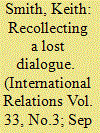

|
|
|
|
|
| Summary/Abstract |
Since its appellation, much work has sought to consolidate neoclassical realism. Specifically, a number of variations on the neoclassical theme have reconceptualised the third-image and carved out a distinctly European neoclassical variant. This article contributes by recollecting the Structural Realism of Logic of Anarchy. In unpacking Structural Realism’s framework and dissecting its engagement with inter alia Kenneth Waltz, this article illustrates the importance of Logic’s conceptualisation of the system, particularly in terms of anarchy’s logic. This framework can enrich a number of debates within the neoclassical realist community, especially concerning third-image change and the possibility of a neoclassical realism in and of Europe, while also contributing to debates regarding the strategic actor-ness of the European Union. While Logic and its framework might appear dated, the article submits that one of its principal motifs, anarchy, along with realism’s normative ethos may remind us of International Relation’s (IR’s) healthy pluralism.
|
|
|
|
|
|
|
|
|
|
|
|
|
|
|
|
| 10 |
ID:
103655
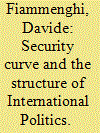

|
|
|
|
|
| Publication |
2011.
|
| Summary/Abstract |
Realist scholars have long debated the question of how much power states need to feel secure. Offensive realists claim that states should constantly seek to increase their power. Defensive realists argue that accumulating too much power can be self-defeating. Proponents of hegemonic stability theory contend that the accumulation of capabilities in one state can exert a stabilizing effect on the system. The three schools describe different points along the power continuum. When a state is weak, accumulating power increases its security. This is approximately the situation described by offensive realists. A state that continues to accumulate capabilities will eventually trigger a balancing reaction that puts its security at risk. This scenario accords with defensive realist assumptions. Finally, when the state becomes too powerful to balance, its opponents bandwagon with it, and the state's security begins to increase again. This is the situation described by hegemonic stability theory. These three stages delineate a modified parabolic relationship between power and security. As a state moves along the power continuum, its security increases up to a point, then decreases, and finally increases again. This modified parabolic relationship allows scholars to synthesize previous realist theories into a single framework.
|
|
|
|
|
|
|
|
|
|
|
|
|
|
|
|
| 11 |
ID:
101281
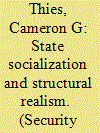

|
|
|
|
|
| Publication |
2010.
|
| Summary/Abstract |
One of the common criticisms of Kenneth Waltz's Theory of International Politics is that its structural model is rather spare. This paper enriches neorealism by specifying the conditioning effects of competition and socialization operating on behalf of the international structure. Despite its neglected status in neorealist theory, I argue that socialization produces important effects on interstate interaction. I develop a model of the socialization process that uses role theory to demonstrate how interstate interaction is structured at the micro-level. Consistent with neorealism, the model assumes that socialization is heavily conditioned by material capabilities, and operates mainly on the adjustment of state behavior. I analyze several episodes of U.S. history to demonstrate that neorealism can explain how unit-level behavior is structured through socialization. The resulting elaboration of neorealism offers a more fully specified structural theory of international politics.
|
|
|
|
|
|
|
|
|
|
|
|
|
|
|
|
| 12 |
ID:
090147
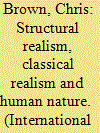

|
|
|
|
|
| Publication |
2009.
|
| Summary/Abstract |
Kenneth Waltz's Theory of International Politics is a modern classic, and deserves to be read the way classic texts ought to be read, i.e. in context and in its own terms. Recovering the context in this case is difficult because of the changes in the discourse since 1979, but one difference between the contemporary and the current reception of the text does seem clear - Waltzian structural realism (or neorealism) is now, but was not then, seen as breaking with the traditions of classical realism. How is this discontinuity to be understood? Part of the answer lies in the rhetoric employed by participants in this debate, but, more substantively, there is a genuine disagreement between neorealism and classical realism over the role played by human nature in international relations. Waltzian neorealism appears, contrary to the tradition, to reject any major role for human nature, describing theories that emphasise this notion as `reductionist'; however, on closer examination, the picture is less clear-cut. Waltz's account of human nature can be related quite closely to the major strands in the realist genealogy, but at a tangent to them. Interestingly, and perhaps unexpectedly, it is also compatible with at least some of the findings of contemporary evolutionary psychology.
|
|
|
|
|
|
|
|
|
|
|
|
|
|
|
|
| 13 |
ID:
111593
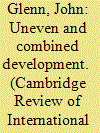

|
|
|
|
|
| Publication |
2012.
|
| Summary/Abstract |
Although Justin Rosenberg's academic writings have from the very beginning attempted to provide an alternative to neorealism in the form of Trotsky's theory of uneven and combined development (U&CD), his attempts at actually replacing it with a general theory of his own have been relatively recent. His initial attempts raised much interest and several responses. In his latest paper, 'Basic problems in the theory of uneven and combined development, part II: unevenness and political multiplicity' (Cambridge Review of International Affairs, 23:1, 2010, 165-189), Rosenberg acknowledges that in actual fact, despite his attempts to provide an alternative to neorealism, his own theory presupposed political multiplicity, and therefore in his latest article he has sought to rectify this by providing an account of the emergence of 'politically fragmented space' which is explicitly grounded in historical materialism (Pozo-Martin, Cambridge Review of International Affairs, 20:4, 2007, 554). As such, it is to be welcomed. However, this article argues that if we are to accept Rosenberg's theory of the emergence of multiplicity then it must provide a better explanation than other competing accounts. By using an alternative explanation of the rise of the international, this article demonstrates that Rosenberg's paper has failed to do this, and instead argues for the existence of a transhistorical anarchic environment arising from social rather than political multiplicity. However, U&CD is then used to explain both the intra- and inter-societal stratifications (the latter in terms of distributional structure) that arise. Associated with these stratifications is the inextricable intertwining of the modes of production and modes of inter-state competition. From this combination emerges the general tendencies of societal development, which then need to be applied to the concrete circumstances of history. In so doing, we need to account for the different analytical registers of genesis, structure, epoch and conjuncture and the unique concatenation of factors that pertain for each of these (Callinicos, International Politics, 6:3, 2005, 362).
|
|
|
|
|
|
|
|
|
|
|
|
|
|
|
|
| 14 |
ID:
086293
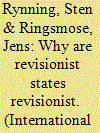

|
|
|
|
|
| Publication |
2008.
|
| Summary/Abstract |
In this article, we argue that Realism recently has eschewed big and important questions of war and peace and that revived Classical Realism can help bring Realism back on track. Modern Realists tend to assume that states are either all status quo players or all revisionists, and the result is a slippery grasp of the sources and dynamics of international change. To revive Classical Realism, we examine three dominant sets of criticism. We notably return to the classical texts of Realism to show that the classics were in fact not reductionist: they did not reduce either systemic or national phenomena (third and second image theory) to human nature (first image). Classical Realists understood the many intricate and delicate connections between these levels, and it is modern era Realists who are reductionists because they reduce explanations to systemic phenomena. We show how Classical Realism can respond in strength to its critics and ask the kind of research questions that again will advance our understanding of international change.
|
|
|
|
|
|
|
|
|
|
|
|
|
|
|
|
|
|
|
|
|